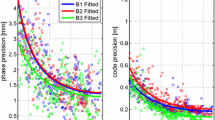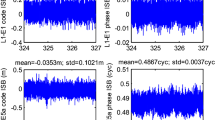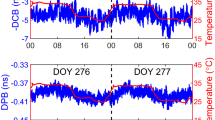Abstract
The proper choice of stochastic model is of great importance to global navigation satellite system (GNSS) data processing. Whereas extensive investigations into stochastic modeling are mainly based on the relative (or differential) method employing zero and/or short baselines, this work proposes an absolute method that relies upon a stand-alone receiver and works by applying the least-squares variance component estimation to the geometry-free functional model, thus facilitating the characterization of stochastic properties of multi-frequency GNSS observables at the undifferenced level. In developing the absolute method, special care has been taken of the code multipath effects by introducing ambiguity-like parameters to the code observation equations. By means of both the relative and absolute methods, we characterize the precision, cross and time correlation of the code and phase observables of two newly emerging constellations, namely the Chinese BDS and the European Galileo, collected by a variety of receivers of different types at multiple frequencies. Our first finding is that so far as the precision is concerned, the absolute method yields nearly the same numerical values as those derived by the zero-baseline-based relative method. However, the two methods give contradictory results with regard to the cross correlation, which is found (not) to occur between BDS phase observables when use has been made of the relative (absolute) method. Our explanation to this discrepancy is that the cross correlation found in the relative method originates from the parts (antenna, cable, low noise amplifier) shared by two receivers creating a zero baseline. The time correlation is only of significance when the multipath effects are present, as is the case with the short-baseline-based relative method; this correlation turns out to be largely weaker (or ideally absent) in the absolute (or zero-baseline-based relative) method. Moreover, with the absolute method, the stochastic properties determined for two receivers of the same type but subject to different multipath effects are virtually the same. We take this as a convincing evidence that the absolute method is robust against multipath effects. Hence, the absolute method proposed in the present work represents a promising complement to the relative method and appears to be particularly beneficial to GNSS positioning, navigation and timing technologies based on the undifferenced observables, typically the precise point positioning.





















Similar content being viewed by others
Data availability statement
RINEX observation data of MGEX stations and broadcast ephemeris are obtained from the online archives of the Crustal Dynamics Data Information System, ftp://cddis.gsfc.nasa.gov; RINEX observation data collected in the Curtin university are accessed from the website of Curtin GNSS Research Center, http://saegnss2.curtin.edu.au/ldc/; RINEX observation data of Hong Kong CORS is downloaded from the Hong Kong Geodetic Survey Services, https://www.geodetic.gov.hk/en/index.htm. RINEX observation data collected in Wuhan is available at https://pan.baidu.com/s/1CYVPnWGvb0-_S8zS-VGD_A (Extraction code: rgex).
References
Amiri-Simkooei A (2007) Least-squares variance component estimation: theory and GPS applications. PhD Thesis, Delft University of Technology
Amiri-Simkooei A, Teunissen P, Tiberius C (2009) Application of least-squares variance component estimation to GPS observables. J Surv Eng 135:149–160
Amiri-Simkooei A, Zangeneh-Nejad F, Asgari J (2013) Least-squares variance component estimation applied to GPS geometry-based observation model. J Surv Eng 139:176–187
Bona P (2000) Precision, cross correlation, and time correlation of GPS phase and code observations. GPS Solut 4:3–13
Brunini C, Azpilicueta F (2010) GPS slant total electron content accuracy using the single layer model under different geomagnetic regions and ionospheric conditions. J Geodesy 84:293–304
Cai C, Gao Y (2013) Modeling and assessment of combined GPS/GLONASS precise point positioning. GPS solut 17:223–236
Cai C, He C, Santerre R, Pan L, Cui X, Zhu J (2016) A comparative analysis of measurement noise and multipath for four constellations: GPS, BeiDou, GLONASS and Galileo. Surv Rev 48:287–295
CSNO (2018) Development of the BeiDou Navigation Satellite System (Version 3). http://www.beidou.gov.cn/xt/gfxz/201812/P020190117356387956569.pdf. Accessed 1 July 2019
de Bakker PF, van der Marel H, Tiberius CC (2009) Geometry-free undifferenced, single and double differenced analysis of single frequency GPS, EGNOS and GIOVE-A/B measurements. GPS Solut 13:305–314
de Bakker PF, Tiberius CC, Van Der Marel H, van Bree RJ (2012) Short and zero baseline analysis of GPS L1 C/A, L5Q, GIOVE E1B, and E5aQ signals. GPS Solut 16:53–64
El-Mowafy A (2015) Estimation of multi-constellation GNSS observation stochastic properties using single receiver single satellite data validation method. Surv Rev 47:99–108
ESA (2018) Galileo fact sheet. http://esamultimedia.esa.int/docs/galileo/Galileo_factsheet_2018.pdf. Accessed 1 July 2019
EU (2016) The European GNSS (Galileo) open service signal-in-space interface control document. https://www.gsc-europa.eu/system/files/galileo_documents/Galileo-OS-SIS-ICD.pdf. Accessed 1 July 2019
Eueler HJ, Goad CC (1991) On optimal filtering of GPS dual frequency observations without using orbit information. Bulletin Géodésique 65:130–143
Fritsche M, Dietrich R, Knöfel C, Rülke A, Vey S, Rothacher M, Steigenberger P (2005) Impact of higher order ionospheric terms on GPS estimates. Geophys Res Lett 32:L23311. https://doi.org/10.1029/2005GL024342
Grafarend EW (2000) Mixed integer-real valued adjustment (IRA) problems: GPS initial cycle ambiguity resolution by means of the LLL algorithm. GPS Solut 4:31–44
Hou P, Zhang B, Yuan Y (2019a) Combined GPS + BDS instantaneous single-and dual-frequency RTK positioning: stochastic modelling and performance assessment. J Spat Sci. https://doi.org/10.1080/14498596.2018.1558117
Hou P, Zhang B, Yuan Y, Zhang X, Zha J (2019b) Stochastic modeling of BDS2/3 observations with application to RTD/RTK positioning. Meas Sci Technol. https://doi.org/10.1088/1361-6501/ab1fad
Kazmierski K, Hadas T, Sośnica K (2018) Weighting of multi-GNSS observations in real-time precise point positioning. Remote Sens 10:84. https://doi.org/10.3390/rs10010084
Kedar S, Hajj GA, Wilson BD, Heflin MB (2003) The effect of the second order GPS ionospheric correction on receiver positions. Geophys Res Lett 30:1829. https://doi.org/10.1029/2003GL017639
Khodabandeh A, Teunissen PJ (2016) Array-aided multifrequency GNSS ionospheric sensing: estimability and precision analysis. IEEE Trans Geosci Remote Sens 54:5895–5913
Khodabandeh A, Teunissen P (2018) On the impact of GNSS ambiguity resolution: geometry, ionosphere, time and biases. J Geodesy 92:637–658
Koch K-R (1977) Least squares adjustment and collocation. Bulletin Géodésique 51:127–135
Koch K-R (1978) Schätzung von varianzkomponenten. Allgemeine Vermessungs Nachrichten 85:264–269
Koch K-R (1999) Parameter estimation and hypothesis testing in linear models. Springer, Berlin
Kubik K (1970) The estimation of the weights of measured quantities within the method of least squares. Bulletin Géodésique (1946–1975) 95:21–40
Laurichesse D, Mercier F, Berthias JP, Broca P, Cerri L (2009) Integer ambiguity resolution on undifferenced GPS phase measurements and its application to PPP and satellite precise orbit determination. Navigation 56:135–149
Leick A, Rapoport L, Tatarnikov D (2015) GPS satellite surveying. Wiley, Hoboken
Li B (2016) Stochastic modeling of triple-frequency BeiDou signals: estimation, assessment and impact analysis. J Geodesy 90:593–610
Li B, Shen Y, Xu P (2008) Assessment of stochastic models for GPS measurements with different types of receivers. Chin Sci Bull 53:3219–3225
Liu X, Yuan Y, Huo X, Li Z, Li W (2010) Model analysis method (MAM) on the effect of the second-order ionospheric delay on GPS positioning solution. Chin Sci Bull 55:1529–1534
Liu T, Yuan Y, Zhang B, Wang N, Tan B, Chen Y (2017) Multi-GNSS precise point positioning (MGPPP) using raw observations. J Geodesy 91:253–268
Odijk D, Zhang B, Khodabandeh A, Odolinski R, Teunissen PJ (2016) On the estimability of parameters in undifferenced, uncombined GN network and PPP-RTK user models by means of S-system theory. J Geodesy 90:15–44
Rao CR (1971) Estimation of variance and covariance components—MINQUE theory. J Multivar Anal 1:257–275
Satirapod C, Luansang M (2008) Comparing stochastic models used in GPS precise point positioning technique Empire. Surv Rev 40:188–194
Schönemann E, Becker M, Springer T (2011) A new approach for GNSS analysis in a multi-GNSS and multi-signal environment. J Geod Sci 1:204–214
Smyrnaios M, Schön S, Nicolás ML (2013) Multipath propagation, characterization and modeling in GNSS. In: Jin S (ed) Geodetic sciences-observations, modeling and applications. IntechOpen, London
Teunissen P (1985) Generalized inverses, adjustment, the datum problem and S-transformations. In: Sanso F, Grafarend EW (eds) Optimization of geodetic networks. Springer, Berlin
Teunissen P (1988) Towards a least-squares framework for adjusting and testing of both functional and stochastic models. Technical report 26, Geodetic Computing Centre, Delft, Netherlands
Teunissen PJG (1995) The least-squares ambiguity decorrelation adjustment: a method for fast GPS integer ambiguity estimation. J Geodesy 70:65–82
Teunissen P (2000) Adjustment theory: an introduction. VSSD, Delft
Teunissen P (2006) Testing theory. VSSD, Delft
Teunissen PJ (2018) Distributional theory for the DIA method. J Geodesy 92:59–80
Teunissen PJG, Amiri-Simkooei AR (2008) Least-squares variance component estimation. J Geodesy 82:65–82
Teunissen PJ, Kleusberg A (2012) GPS for geodesy. Springer, Berlin
Teunissen P, De Bakker P (2013) Single-receiver single-channel multi-frequency GNSS integrity: outliers, slips, and ionospheric disturbances. J Geodesy 87:161–177
Teunissen P, Khodabandeh A (2015) Review and principles of PPP-RTK methods. J Geodesy 89:217–240
Teunissen PJG, Montenbruck O (2017) Springer handbook of global navigation satellite systems. Springer, Berlin
Tian Y, Sui L, Xiao G, Zhao D, Tian Y (2019) Analysis of Galileo/BDS/GPS signals and RTK performance. GPS Solut. https://doi.org/10.1007/s10291-019-0831-5
Tiberius C, Kenselaar F (2003) Variance component estimation and precise GPS positioning: case study. J Surv Eng 129:11–18
Tiberius C, Kenselaar F, Tiberius C, Kenselaar F (2000) Variance component estimation for precise GPS positioning. Geodezija ir Kartografija 26:152–159
Wu S, Zhao X, Pang C, Zhang L, Wang Y (2019) A new strategy of stochastic modeling aiming at BDS hybrid constellation in precise relative positioning. Adv Space Res 63:2757–2770
Xu P, Liu Y, Shen Y, Fukuda Y (2007) Estimability analysis of variance and covariance components. J Geodesy 81:593–602
Yang Y, Li J, Xu J, Tang J, Guo H, He H (2011) Contribution of the compass satellite navigation system to global PNT users. Chin Sci Bull 56:2813–2819
Zaminpardaz S, Teunissen PJ (2017) Analysis of Galileo IOV + FOC signals and E5 RTK performance. GPS Solut 21:1855–1870
Zhang B, Teunissen PJ, Yuan Y (2017a) On the short-term temporal variations of GNSS receiver differential phase biases. J Geodesy 91:563–572
Zhang Z, Li B, Shen Y, Yang L (2017b) A noise analysis method for GNSS signals of a standalone receiver. Acta Geodaetica et Geophysica 52:301–316
Zhang B, Chen Y, Yuan Y (2019) PPP-RTK based on undifferenced and uncombined observations: theoretical and practical aspects. J Geodesy 93:1011–1024. https://doi.org/10.1007/s00190-018-1220-5
Acknowledgements
This work was funded by the National Natural Science Foundation of China (Nos. 41774042, 41574015). The first author is supported by the CAS Pioneer Hundred Talents Program. The fourth author acknowledges the LU JIAXI International team program supported by the K.C. Wong Education Foundation and CAS. All this support is gratefully acknowledged.
Author information
Authors and Affiliations
Contributions
Baocheng Zhang proposed the method, designed the research and wrote the paper. Pengyu Hou developed the software, analyzed the data and wrote the paper. Teng Liu improved the computational efficiency of the software and revised the manuscript. Yunbin Yuan supervised the experimental analysis and revised the manuscript.
Corresponding authors
Rights and permissions
About this article
Cite this article
Zhang, B., Hou, P., Liu, T. et al. A single-receiver geometry-free approach to stochastic modeling of multi-frequency GNSS observables. J Geod 94, 37 (2020). https://doi.org/10.1007/s00190-020-01366-8
Received:
Accepted:
Published:
DOI: https://doi.org/10.1007/s00190-020-01366-8




